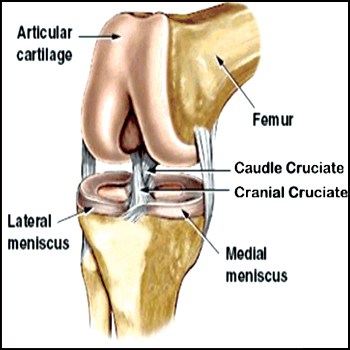Surgical Repair of the Canine ACL

If your pet has torn the cranial cruciate ligament (CCL), this is analogous to a ruptured anterior cruciate ligament (ACL) in people. This ligament is one of the main structures responsible for providing normal stability in the knee. Injury to the anterior or cranial cruciate ligament is quite common in both animals and humans, and is usually caused by hyperextending or twisting the knee while running. This injury is particularly common in human athletes, such as football players or skiers. In dogs, certain breeds such as Labrador retrievers, Rottweilers, Golden Retrievers, mid-sized & large-breed mixes, and pit bulls seem predisposed to this problem.
Multiple studies have demonstrated that surgery is indicated in dogs with a torn or partially torn CCL. In general, dogs with surgery are expected to have less pain, better function, and greater strength long term than dogs without surgery.
Although most animals demonstrate improvement after surgical procedures for a torn CCL, it is important to remember that most animals will not become completely normal. A similar outcome is seen in humans after surgery for this injury.
At least 33% and up to 50% of dogs that sustain a torn CCL will tear their opposite CCL within several years of the initial injury.
Fabellar Tibial Suture (Lateral suture)
The fabellar-tibial suture (more commonly called lateral suture) is a surgical procedure that has been used for many years in managing dogs with torn CCL. Basically the procedure involves opening up the knee (arthrotomy), removing all the damaged ligament and cartilage, and replacing the CCL with a man-made material, usually nylon or stainless steel.
Many studies have been performed on the Lateral suture, and the data is plentiful. In general, the great majority of the dogs will become between 80-85% of normal within 6 months of lateral suture and will continue to improve slightly approximately another year. Most of these dogs can run, jump, play, and swim comfortably. However, some degree of progressive arthritis in the knee is expected, as well as some persistent mild lameness, particularly in large very athletic dogs and all dogs after strenuous exercise.
Tibial Plateau Leveling Osteotomy (TPLO)
Tibial Plateau Leveling Osteotomy (TPLO) is a relatively new surgical procedure that has been widely used for the past twenty years. Because this procedure and the surgical instruments required to perform the procedure are patented, surgeons must be certified to perform TPLO surgery.
TPLO essentially involves making a controlled fracture (osteotomy) in the upper portion of the tibia, just below the knee, rotating the osteotomy into a new position determined by the preoperative radiographs, and fixing the osteotomy with a metal plate and screws. The effect of rotating the osteotomy is that the knee biomechanics are subtly altered such that the dog no longer requires a CCL.
The tibial plateau leveling osteotomy can be performed on any dog, though it is most often used for dogs over 30 pounds or very athletic.
Lateral Suture vs TPLO
The TPLO has caused tremendous debate among veterinary surgeons concerning which surgical procedure is most appropriate for dogs. Some surgeons in the United States recommend lateral sutures as the best option for every patient and others recommend TPLO as the best option for every patient. Beyond Pets Animal Hospital’s opinion is that each procedure has relative advantages and disadvantages, which owners should consider when making their decision.
Advantages of the lateral suture include that it is a relatively quick surgical procedure, which should minimize surgical and anesthetic risk (however at Beyond Pets Animal Hospital, we have found the difference to be only 10-15 minutes). Although not perfect, this procedure has been studied extensively and has a proven and well-defined usually good long-term result. The lateral suture is slightly less expensive to perform. The primary disadvantage of the lateral suture is that most dogs only recover to 85- 90% of normal and take longer to reach this level. There is almost always some progression of arthritis, and intermittent mild lameness persists, especially after exercise. Dogs do well, but they may not be particularly “athletic.”
The primary advantage of TPLO is that the procedure offers the potential for dogs to be considerably better than 85- 90% of normal. In addition, some dogs with very steep tibial plateau angles require TPLO as the lateral suture will fail in these dogs. Our subjective opinion at Beyond Pets Animal Hospital is that this is probably the case in 10-20 % of dogs. The primary disadvantage of TPLO is related to its somewhat more complex nature. Surgery times are slightly longer, and therefore a slight increase in infection rate is expected (although we have not seen any difference in infection rates between the two procedures in this hospital). Because of its complexity, slightly increased anesthesia time, implants, and additional radiographs, TPLO is more expensive to perform.
Postoperative management is the same with either lateral suture or TPLO. Animals need to be kept completely confined for 6- 8 weeks, and maintained on a hand-held lead for another 6- 8 weeks. Even though a fracture is created with TPLO, these dogs are more comfortable in the early postoperative period, and use the leg quicker than those with lateral suture surgery. A recent study failed to show statistical difference between the lateral suture and TPLO 1-1.5 years postoperatively. However, the absolute amount of weight placed on the leg by dogs with TPLO was greater than that of dogs with lateral suture. In addition, for the first 16 weeks after surgery dogs with a TPLO were using the leg more than dogs that had lateral suture surgery.
Because definitive objective data is not yet available comparing long-term (6- 8 years post-op) results of the lateral suture and TPLO, decisions regarding which procedure to perform in dogs with torn CCL should be based on careful consideration of all the above factors. Young, athletic, and large dogs may be good candidates for TPLO.
